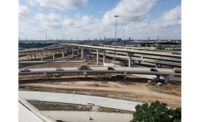In their efforts to bring the levees back to pre-Katrina standards by June 1, contractors fight the clock, labor and material shortages and rising costs, but most of all, the thing that wrecked them last hurricane season: Mother Nature.
 |
| (Photo Credit by Tom Sawyer for ENR ) |
"Every now and then Mother Nature teaches us we don't know what strong is," says James Drinkwater, standing at the Sunrise Pumping station, in Buras, La., in lower Plaquemines Parish. One couldn�t ask for more visual evidence than at this particular location. Not only was a 200-ft I-wall section of the federal hurricane protection levee completely washed away, but a huge scour hole reached at least 20 yards inland to undermine half of Louisiana Hwy. 23, the main thoroughfare running north and south through the parish.
The pumping station remained largely intact, except for some fencing and exterior metal fixtures that were evident in the gaping scour hole adjacent to the highway. "The hole was 15 to 20 ft deep. We didn't need to pull the sheet because it was all gone," says Drinkwater, who is project superintendent for Houma-based LL &G Construction, which won the $7.3-million Corps of Engineers Buras Back Levee contract, which includes construction of 361 ft of concrete T-wall sections at Sunrise and another 200 ft of T-wall and uncapped sheet pile at Hayes Pumping station, about 10 miles north, in Port Sulphur.
The breach at Sunrise was largest in the area. It's difficult to say whether the damage was caused exclusively from overtopping of the levees from storm surge that moved in from the Gulf of Mexico to the west or also from flood waters from the Mississippi River to the east and debris moved by the water and wind. "Nobody knows because nobody was here," Drinkwater says. "They got hit by a terrible lot of stuff and there were a lot of shrimp boats flying around."
From the beginning, the contractor has struggled to hold back the water effectively enough to make the repairs, a testimonial to the challenges and seeming futility of the task. "There was so much water intrusion that, for months, we couldn't work," says Drinkwater, who has been working 11 hours a day, seven days a week and living in a trailer on site since February. The Corps initially sealed the breach by constructing an emergency rock dyke. LL&G brought in temporary pumps to drain the work site and fortified the dyke, raising it six feet to elevation 10, to provide temporary flood protection, Drinkwater said.
The tidal surge continued to flood the work site. "We tried sand, clay and bentonite. That didn't stop it," Drinkwater said. "On the inside, we started hauling dirt even though we'll have to haul it back again because we couldn�t compact it. Then we put in flow able fill and a plastic membrane on the other side."
The contractor didn't build a coffer dam, citing the unavailability of material and the time factor. Everyone is trying to meet the June 1 deadline. "The Corps is saying that is elevation 10," says Drinkwater, eyeing the rock dyke. Still, in March, he wasn't certain it would be enough to protect the worksite through April's rising tides. "If you get a good size wind, we'll get an extra rise of two feet or so," he said. "If the water gets high enough, it will get underneath the rock and get the worksite wet."
The plans indicated that the rock dyke was supposed to end at minus seven feet, but Drinkwater said his crews dug to minus 13 and 14 and still hit rock. With the fast-approaching deadline, there simply isn�t enough time to second guess everything.
Maintaining a labor force to keep pace with the grueling schedule is the superintendent's biggest challenge. "I've got people from all over the country," he says. "I could use five more welders today, but I can't get them."
With so much levee work, materials are at a premium. "We had to stockpile material in order to have enough," says Wayne Ledet, one of the owners of LL&G. "That's one of the things I told the Corps. You�ve got to allow us to stockpile if we are going to get this job done."
Still, contractors like LL&G bid numerous jobs, recognizing that levee repairs represent the biggest chunk of the construction pie, at least until June 1. "I bid on 100 projects," says Ledet, whose company is currently working on three levee repair contracts.
For the two pumping stations, LL & G is placing about 12,000 yd of clay and 5,000 yd of sand, Ledet says. At Bayou Bienvenue in St. Bernard Parish, the contractor will place 40,000 tons of rock, 50,000 yd of sand and 8,000 yd of clay to repair two breaches with a combine length of 310 ft. The $8.5-million contract also includes electrical and mechanical repairs to the flood control gate structure that separates Bayou Bienvenue and the Mississippi River Gulf Outlet. Under a third contract at the Air Products plant in Orleans Parish, LL&G will place 30,000 yd of clay in a 200-ft-long work site to seal a 120-ft breach.
"Clay before the storm was $15 to $25 per yard, and now it's $45," Ledet said. "None of these jobs have worked out the way any of us expected - labor, equipment, so many unknowns."
At Sunrise in Buras, it�s difficult to get labor because "it's a pretty remote area and the living conditions aren't great," Ledet said. It's a lonely drive (through a Sheriff's office checkpoint) to the site that is situated in a parish where virtually every home was destroyed. Although only about 40 miles from downtown New Orleans and the night life of the French Quarter, Sunrise seems like the end of the earth at night. "I brought a boat down there, so the guys could go fishing at night and have something to do," Ledet says.
He has been building flood control structures and pump stations for 15 years for both the Corps and local governments. In spite of the widespread failures throughout the 350 miles of the levee system, Ledet feels that consolidating all levee construction, operation and maintenance under the Corps is the only way to go. "Locals don't understand compaction and quality control," Ledet says. "If they take the levee work from the Corps, there will be problems because it will be all about locals and buddies."



Post a comment to this article
Report Abusive Comment